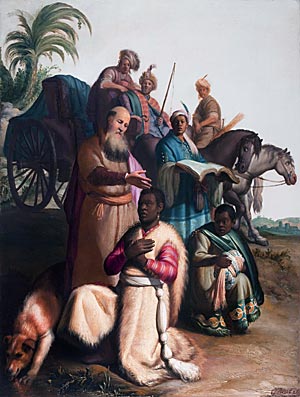Readings:
Isaiah 53:1-9
Psalm 68:28-35
Acts 8:26-40
Matthew 19:3-12Preface of a Saint (1)
PRAYER (traditional language)
Holy One of love, thou didst call thy servant Simeon Bachos to study thy Word and led him to the waters of baptism, making him thy evangelist to Ethiopia: give to us the grace to follow where thou leadest, overcoming the barriers that divide and diminish thy people, that we may behold thee in all thy glory; through our Savior and Lord Jesus Christ, who with thee and the Holy Spirit liveth and reigneth for ever and ever. Amen.
PRAYER (contemporary language)
Holy One of love, you called your servant Simeon Bachos to study your word and led him to the waters of baptism, making him your evangelist to Ethiopia: give us the grace to follow where you lead, overcoming the barriers that divide and diminish your people, that we may behold you in all your glory; through our Savior and Lord Jesus Christ, who with you and the Holy Spirit lives and reign for ever and ever. Amen.
Lessons revised at General Convention 2024
Return to Lectionary Home Page
Webmaster: Charles Wohlers
Last updated: 10 July 2024
SIMEON BACHUS, THE ETHIOPIAN EUNUCH
EVANGELIST IN AFRICA, N. T.
 Philip the Evangelist was told by an angel to go to the road from Jerusalem to Gaza, and there he encountered the Ethiopian eunuch, the treasurer of the Candace, Queen of the Ethiopians. The eunuch had been to Jerusalem to worship and was returning home. Sitting in his chariot, he was reading the Book of Isaiah, specifically Isaiah 53:7-8. Philip asked the Ethiopian, "Do you understand what you are reading?" He said he did not ("How can I understand unless I have a teacher to teach me?"), and asked Philip to explain the text to him. Philip told him the Gospel of Jesus, and the Ethiopian asked to be baptized. They went down into a water source, traditionally thought to be the Dhirweh fountain near Halhul, and Philip baptized him.
Philip the Evangelist was told by an angel to go to the road from Jerusalem to Gaza, and there he encountered the Ethiopian eunuch, the treasurer of the Candace, Queen of the Ethiopians. The eunuch had been to Jerusalem to worship and was returning home. Sitting in his chariot, he was reading the Book of Isaiah, specifically Isaiah 53:7-8. Philip asked the Ethiopian, "Do you understand what you are reading?" He said he did not ("How can I understand unless I have a teacher to teach me?"), and asked Philip to explain the text to him. Philip told him the Gospel of Jesus, and the Ethiopian asked to be baptized. They went down into a water source, traditionally thought to be the Dhirweh fountain near Halhul, and Philip baptized him.
After this, Philip was suddenly taken away by the Spirit of the Lord, and the eunuch "went on his way rejoicing" (verse 39).
Irenaeus of Lyons in his book Adversus haereses (Against the Heresies, an early anti-Gnostic theological work) 3:12:8 (180 AD), wrote regarding the Ethiopian eunuch, "This man (Simeon Bachos the Eunuch) was also sent into the regions of Ethiopia, to preach what he had himself believed, that there was one God preached by the prophets, but that the Son of this (God) had already made (His) appearance in human flesh, and had been led as a sheep to the slaughter; and all the other statements which the prophets made regarding Him." In Ethiopian Orthodox Tewahedo tradition he was referred to as Bachos and is known as an Ethiopian Jew with the name Simeon also called the Black, a name used in Acts 13:1.
"Candace" was the name given in Greco-Roman historiography to all the female rulers or consorts of the Kingdom of Kush (now part of Sudan). "Ethiopian" was a Greek term for black-skinned peoples generally, often applied to Kush (which was well known to the Hebrews and often mentioned in the Hebrew Bible).
Some scholars, such as Frank M. Snowden, Jr., interpret the story as emphasizing that early Christian communities accepted members regardless of race: "Ethiopians were the yardstick by which antiquity measured colored peoples." Others, such as Clarice Martin, write that it is a commentary on the religion rather than on its adherents, showing Christianity's geographical extent; Gay L. Byron goes further, saying, "The Ethiopian eunuch was used by Luke to indicate that salvation could extend even to Ethiopians and Blacks."
more at Wikipedia